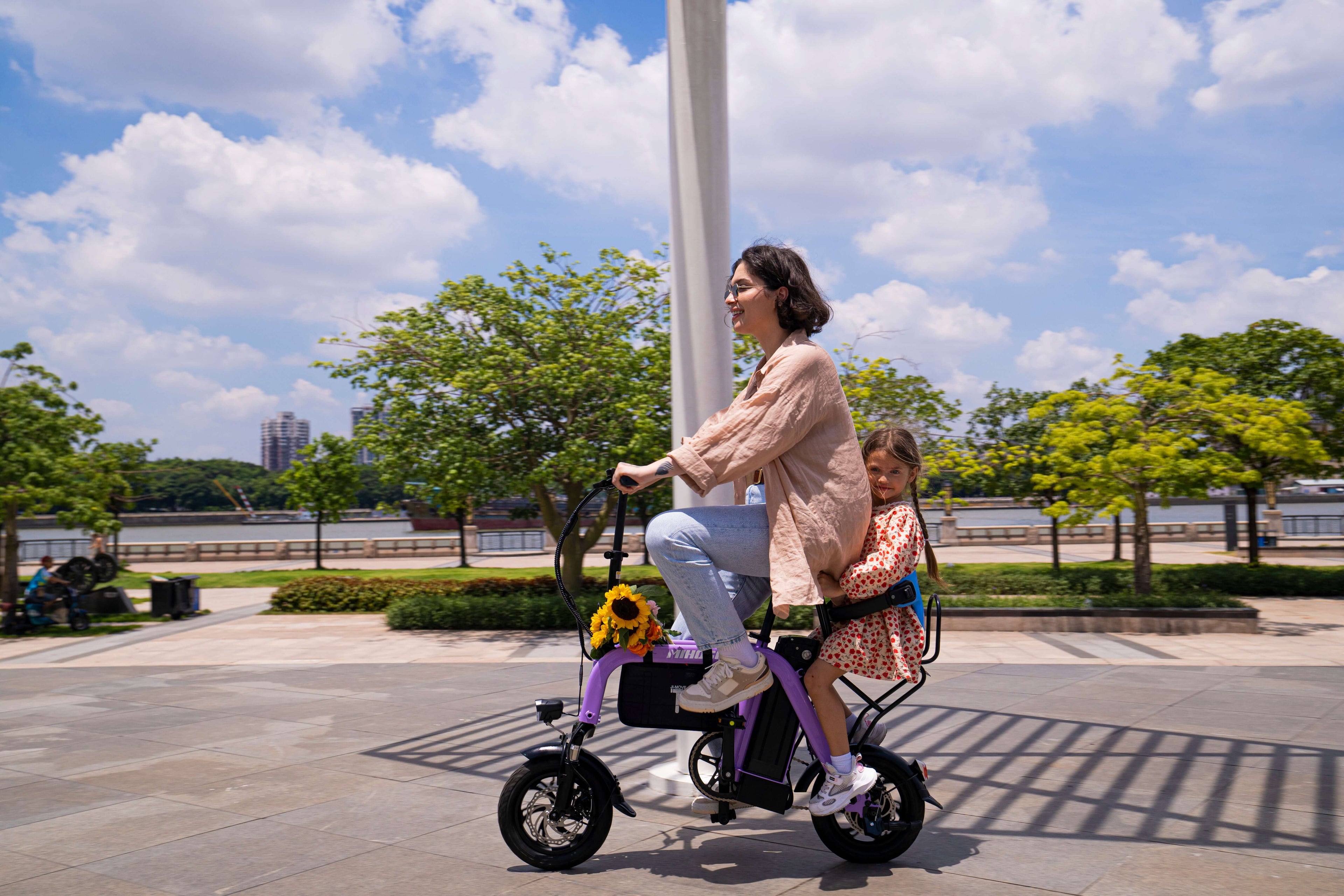Understanding Spoke Stress on Different Mihogo Models by Terrain
Mihogo Air750 Max: Carbon Fiber Powerhouse
- Motor Power: 750W | Range: 121 miles | Top Speed: 25MPH
- Best Terrain: Road cycling, light trails, urban commuting
- Spoke Considerations: The carbon fiber frame reduces overall weight stress, but the powerful 750W motor increases torque-related spoke tension
Mihogo ONE Utility E-Bike: Heavy-Duty Workhorse
- Motor Power: 750W | Range: 167 miles | Top Speed: 25MPH
- Best Terrain: Cargo hauling, utility work, urban delivery
- Spoke Considerations: Higher weight capacity means increased spoke stress, especially on rear wheels during heavy loading
Mihogo RX 2.4: Commuter Folding Bike
- Motor Power: 500W | Range: 40 miles | Top Speed: 23MPH
- Best Terrain: City streets, bike paths, short commutes
- Spoke Considerations: Folding mechanism requires extra attention to spoke tension after folding/unfolding cycles
Mihogo Mini: Compact Urban Rider
- Motor Power: 350W | Range: 62 miles | Top Speed: 21.9MPH
- Best Terrain: Smooth urban surfaces, bike lanes, indoor storage areas
- Spoke Considerations: Smaller wheels mean higher spoke tension ratios, requiring more frequent maintenance
Common Causes of Spoke Failures in Electric Bikes
1. Improper Spoke Tension
Spokes should sound high-pitched when pinched like guitar strings – if they sound dull, they're loose and at risk of failure. E-bike owners should be tensioning rear wheels every 6 months, especially on more affordable models.
2. Hub Motor Weight Distribution
The motor's unsprung weight affects the wheel more dramatically than rider weight, causing excessive strain during impacts. This is particularly problematic for high-powered models like the Mihogo Air750 Max and ONE Utility.
3. Inadequate Spoke Gauge for E-Bike Use
Most motor wheel combinations use 12-gauge spokes, but many manufacturers put thin spokes that aren't strong enough for motor wheel stress. Upgrading to 13-gauge spokes at the elbow and 14-gauge at the rim provides better tension distribution.
4. Corrosion and Environmental Factors
Rear wheel spokes are more prone to corrosion than front wheels due to road spray and increased stress from being the drive wheel.
Professional Wheel Maintenance Schedule for Mihogo E-Bikes
Monthly Checks (All Models)
- Visual spoke inspection for cracks or corrosion
- Wheel truing check using the pencil method
- Tire pressure verification (proper pressure reduces rim flex)
Quarterly Maintenance (Every 3 Months)
- Professional spoke tension measurement
- Deep cleaning of hub motor and spoke interfaces
- Spoke replacement of any questionable spokes
Bi-Annual Service (Every 6 Months)
- Complete wheel rebuild if multiple spoke failures occur
- Hub motor bearing inspection
- Preventive spoke upgrades to higher-gauge options
Step-by-Step Spoke Replacement Guide
Replacing broken spokes on your e-bike is manageable with the right tools and knowledge. Here's the complete process:
Tools Required:
- Spoke wrench (correct size for your Mihogo model)
- Replacement spokes (13-gauge recommended)
- Tire levers
- Truing stand (optional but recommended)
Replacement Process:
- Remove the wheel from your Mihogo e-bike
- Deflate tire completely and remove if necessary for better access
- Locate broken spoke and remove using spoke wrench (counterclockwise)
- Install new spoke ensuring proper threading into hub
- Hand-tighten nipple and gradually increase tension
- Check wheel trueness and adjust neighboring spokes if needed
Terrain-Specific Maintenance for Mihogo Models
For Mihogo Air750 Max (Carbon Fiber)
Road and Light Trail Use:
- Focus on spoke tension consistency due to high motor power
- Monitor carbon rim-spoke interface for stress cracks
- Ideal for: Paved roads, well-maintained bike paths, light gravel
For Mihogo ONE Utility (Heavy Cargo)
Urban Delivery and Cargo Use:
- Inspect rear spokes weekly when carrying heavy loads
- Consider 32-spoke wheel upgrade for maximum durability
- Ideal for: City deliveries, grocery runs, tool/equipment transport
For Mihogo RX 2.4 (Folding Commuter)
Urban Commuting:
- Check spoke tension after each folding cycle
- Pay special attention to hinge-area stress points
- Ideal for: Daily commutes, mixed transport (car trunk/train), apartment storage
For Mihogo Mini (Compact Urban)
Smooth Surface Riding:
- Monitor spoke tension more frequently due to smaller wheel size
- Avoid rough terrain that could overstress compact wheels
- Ideal for: Bike lanes, smooth sidewalks, indoor/campus riding
Advanced Spoke Upgrade Options
Sapim Strong Spokes
Industry experts recommend Sapim Strong spokes which are 13-gauge at the elbow and narrow to 14-gauge at the rim, providing superior tension distribution.
Increased Spoke Count
Upgrading from 28 to 32 spokes significantly improves wheel strength, especially for heavier riders or high-power motors.
Professional Wheel Building
A properly built wheel by an experienced wheel builder often eliminates spoke problems entirely.
When to Seek Professional Help
Contact a certified e-bike mechanic if you experience:
- Multiple spoke failures (3+ in short timeframe)
- Wheel wobbling that can't be corrected
- Hub motor noise or resistance
- Rim damage or cracks
Cost-Effective Prevention Strategies
- Avoid Impact Damage: Don't jump curbs or slam into potholes – the motor's unsprung weight amplifies these impacts
- Regular Tension Checks: Use the "guitar string" test monthly
- Quality Upgrades: Invest in better spokes during your first replacement
- Professional Assembly: Have wheels professionally tensioned after any spoke work
Conclusion: Keeping Your Mihogo Rolling Strong
Spoke maintenance doesn't have to be a constant headache. By understanding your specific Mihogo model's requirements, following a regular maintenance schedule, and choosing quality replacement parts, you can dramatically reduce spoke failures and extend your wheel's lifespan.
Remember: Once spokes start breaking, it's often time for a complete rebuild with stronger components. Don't wait for multiple failures – address the underlying issues early to keep your Mihogo e-bike performing at its best.
- Electric Bike Battery Maintenance Guide - External resource for complete e-bike care
- Understanding E-Bike Motor Types - Wikipedia reference for technical specifications
- Professional Wheel Building Techniques - Sheldon Brown's comprehensive wheel building guide
Hub Motor Maintenance - Future guide covering motor-specific care
E-Bike Tire Selection - Upcoming article on tire choices for different Mihogo models
Winter E-Bike Storage - Seasonal maintenance guide for optimal longevity








